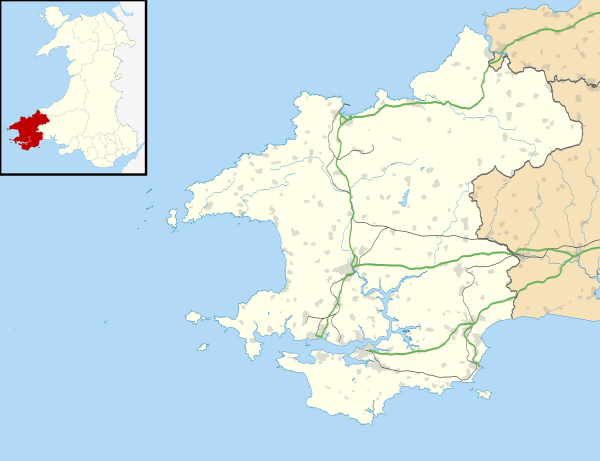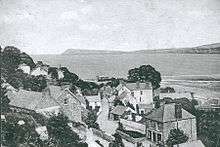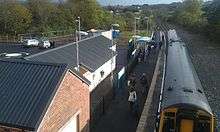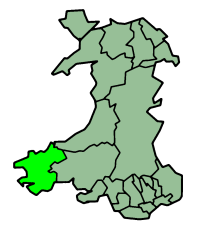Goodwick
| Goodwick | |
| Welsh: Wdig | |
| Part of Goodwick Sea Front |
|
 Goodwick |
|
| Population | (recorded under Fishguard) |
|---|---|
| OS grid reference | SM945381 |
| Community | Fishguard and Goodwick |
| Principal area | Pembrokeshire |
| Ceremonial county | Dyfed |
| Country | Wales |
| Sovereign state | United Kingdom |
| Post town | GOODWICK |
| Postcode district | SA64 |
| Dialling code | 01348 |
| Police | Dyfed-Powys |
| Fire | Mid and West Wales |
| Ambulance | Welsh |
| EU Parliament | Wales |
| UK Parliament | Preseli Pembrokeshire |
| Welsh Assembly | Preseli Pembrokeshire |
|
|
Coordinates: 52°00′11″N 4°59′31″W / 52.003°N 4.992°W

Goodwick (English /ˈɡʊdᵻk/; Welsh: Wdig) is a coastal town in Pembrokeshire, south-west Wales, immediately west of its twin town of Fishguard. The coasts of Wales were subjected to Norse raids during the Viking Era and, in the latter 10th century, Norse trading posts and settlements became established. The place name probably derives from a combination of the old Norse forms: góðr (good) and vik (bay or cove) giving góðrvik. Compare formation with Reykjavík (Smoking Bay) where reykr = 'smoke'.[1] Goodwick was a small fishing village in the parish of Llanwnda, but in 1887 work commenced on a railway connection and harbour, and the village grew rapidly to service this. The main industry is now tourism although in the town's industrial past brick making was once an important industry. Some fishing still takes place on a small scale but most activity is centered on Milford Haven. The local beach, Goowick Sands, is where the defeated French invasion force assembled prior to their unconditional surrender on 24 February 1797.
Governance
A separate electoral ward exists with the same name. The total population of this ward at the 2011 census was 1,988.[2]
Fishguard Harbour

The harbour was constructed by blasting 1.6 million tonnes of rock from the hillside to make a 900 m long breakwater. The quarried-out area became the quay. The harbour was finally opened on 30 August 1906. Planned to be the end of the Great Western Railway's line and its major sea port, replacing Neyland, problems with the harbour (known as Fishguard Harbour) prevented larger ocean liners from docking. Accordingly, the harbour has a smaller inner breakwater protecting the remaining open side.
The Great Western Railway ordered three new steamers for its service to Rosslare, St David, St George and St Patrick.[3]
RMS Mauretania visited once in 1909 although passengers had to board by tender when transferring to and from the London train. The smaller breakwater was built as part of the preparations for the visit of the RMS Mauretania and is sometimes known as the "Mauretania Mole". The breakwater lead to unanticipated silting, and the prospect of future visits from larger liners was abandoned. Directly above the harbour is a small estate known as "Harbour Village", built to house workers during the construction of the harbour.
The port now accommodates a ferry and seasonal fast catamaran service to Rosslare operated by Stena Line.
The RNLI operate an all weather Trent class lifeboat, the Blue Peter VII, and a class D inshore lifeboat from within the harbour.[4]
In October 2011 plans for Fishguard & Goodwick Marina were revealed in the Western Telegraph. The developers Conygar who hope to invest £100 million into the project have submitted plans to Pembrokeshire County Council for a 450 berth marina, 253 new residential flats and a 19-acre platform for the potential expansion of the existing Stena Line port. The scheme would also create a publicly accessible promenade and waterfront, and visitor parking as well as workshops, stores and ancillary facilities. If approved most of the proposed new developments will be sited by reclaiming land from the sea bed within the two existing breakwaters mainly near the current 'Ocean Lab' and alongside the existing ferry terminal access roads. Conygar have also exchanged contracts to acquire an eleven-acre site for a lorry stop and distribution park on the perimeter of the Stena Line owned port.[5][6] [7]
Transport


Fishguard & Goodwick railway station served local rail travellers from the town, and from nearby Fishguard, until the line was effectively closed to such passengers by the reduction in service to boat trains only in 1964. After this, trains only served Fishguard Harbour and the station fell into disrepair. Following investment from Network Rail and Pembrokeshire County Council the station has now been re-built and was reopened for passengers again, on 14 May 2012. It is served by the boat trains and the newly introduced local trains.
As mentioned above, the harbour is used by Stena Line ferries to Rosslare Europort in Ireland. In 2013, the conventional ferry MS Stena Europe has two sailings each way per day, one around lunch time and one in the dead of night. The Stena Lynx III fast ferry operated in the summer only until the end of the 2011 season. Her schedule, for instance in the 2010 season consisted of a morning departure to Rosslare and a late afternoon arrival into Fishguard Harbour.
The town is served by the Fishguard town service bus, which runs alternately from Harbour Village or Stop-and-Call to Fishguard town hall. Two Fishguard - St Davids bus routes also pass through the town.
Stop-and-Call
Originally a separate settlement, Stop-and-Call has now become contiguous with Goodwick. It sits at the point where Goodwick Hill begins to level out after climbing 100 metres in about 1 km from the centre of Goodwick.[8] A map dating from 1891 shows the area as being moorland, with very few buildings;[9] at this time it was in the parish of Llanwnda. Kelly's Directory for 1895 does not mention the Stop-and-Call[10] nor does it appear on a map which dates from ca. 1850.
Early aviation

The first successful flight from Britain to Ireland was made from Goodwick's Harbour Village on 22 April 1912 by Denys Corbett Wilson, flying a Bleriot XI. The flight lasted one hour 40 minutes, with landfall near Enniscorthy, Ireland. The achievement was commemorated in Centenary Celebrations held in Fishguard and Goodwick on the weekend of 21/22 April 2012 and in a specially commissioned stage play by Derek Webb, called '100 Minutes' which was performed in Fishguard and Wexford the same week.[11]
References
Notes
- ↑ "Linguistic Research Center, The University of Texas at Austin".
- ↑ "Ward population 2011". Retrieved 18 April 2015.
- ↑ "Irish Channel Steamers". Manchester Courier and Lancashire General Advertiser. Manchester. 15 January 1906. Retrieved 13 October 2015 – via British Newspaper Archive. (subscription required (help)).
- ↑ "Lifeboat Station : Fishguard". RNLI.
- ↑ http://www.conygar.com/Project/Fishguard/4 CONYGAR website, Plans and Gallery of images
- ↑ Western Telegraph article; Planning submitted for £100m Fishguard marina plan
- ↑ County Echo; marina plans
- ↑ Photograph at Geograph
- ↑ Ordnance Survey, 6 inch map of Pembrokeshire, 1891
- ↑ Kelly's Directory of Monmouthshire & S Wales, 1895
- ↑ Western Mail article; Goodwick marks centenary of first flight
Bibliography
- Cowsill, Miles (1990). Fishguard Rosslare. Kilgetty, Pembrokeshire: Ferry Publications. ISBN 1871947065.
- Cowsill, Miles (1993). Ferries from Pembrokeshire (Rev. and 2nd ed.). Kilgetty, Pembrokeshire: Ferry Publications. ISBN 1871947146.
- Coswill, Miles (2006). Fishguard-Rosslare: The Official 1906-2006 Anniversary Book. Ramsey, Isle of Man: Ferry Publications. ISBN 1871947820.
- Merrigan, Justin (2010). Fishguard-Rosslare: The Album. Ramsey, Isle of Man: Ferry Publications. ISBN 9781906608248.
External links
| Wikimedia Commons has media related to Goodwick. |
- Images of the proposed new marina development
- Images of the proposed new marina development (overhead view)
